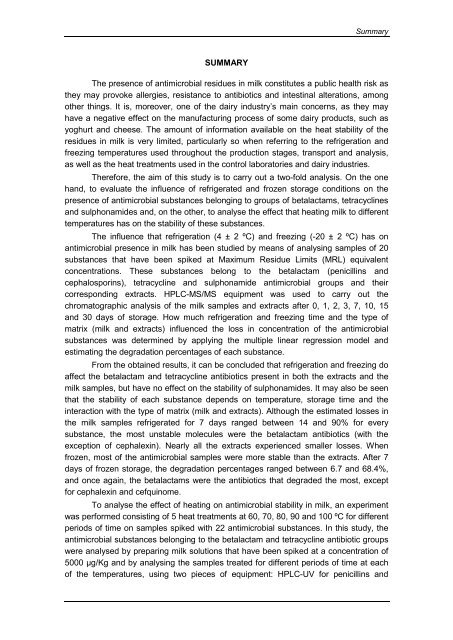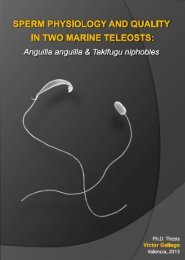termoestabilidad de sustancias antimicrobianas en la leche - RiuNet
termoestabilidad de sustancias antimicrobianas en la leche - RiuNet
termoestabilidad de sustancias antimicrobianas en la leche - RiuNet
You also want an ePaper? Increase the reach of your titles
YUMPU automatically turns print PDFs into web optimized ePapers that Google loves.
SUMMARY<br />
Summary<br />
The pres<strong>en</strong>ce of antimicrobial residues in milk constitutes a public health risk as<br />
they may provoke allergies, resistance to antibiotics and intestinal alterations, among<br />
other things. It is, moreover, one of the dairy industry’s main concerns, as they may<br />
have a negative effect on the manufacturing process of some dairy products, such as<br />
yoghurt and cheese. The amount of information avai<strong>la</strong>ble on the heat stability of the<br />
residues in milk is very limited, particu<strong>la</strong>rly so wh<strong>en</strong> referring to the refrigeration and<br />
freezing temperatures used throughout the production stages, transport and analysis,<br />
as well as the heat treatm<strong>en</strong>ts used in the control <strong>la</strong>boratories and dairy industries.<br />
Therefore, the aim of this study is to carry out a two-fold analysis. On the one<br />
hand, to evaluate the influ<strong>en</strong>ce of refrigerated and froz<strong>en</strong> storage conditions on the<br />
pres<strong>en</strong>ce of antimicrobial substances belonging to groups of beta<strong>la</strong>ctams, tetracyclines<br />
and sulphonami<strong>de</strong>s and, on the other, to analyse the effect that heating milk to differ<strong>en</strong>t<br />
temperatures has on the stability of these substances.<br />
The influ<strong>en</strong>ce that refrigeration (4 ± 2 ºC) and freezing (-20 ± 2 ºC) has on<br />
antimicrobial pres<strong>en</strong>ce in milk has be<strong>en</strong> studied by means of analysing samples of 20<br />
substances that have be<strong>en</strong> spiked at Maximum Residue Limits (MRL) equival<strong>en</strong>t<br />
conc<strong>en</strong>trations. These substances belong to the beta<strong>la</strong>ctam (p<strong>en</strong>icillins and<br />
cephalosporins), tetracycline and sulphonami<strong>de</strong> antimicrobial groups and their<br />
corresponding extracts. HPLC-MS/MS equipm<strong>en</strong>t was used to carry out the<br />
chromatographic analysis of the milk samples and extracts after 0, 1, 2, 3, 7, 10, 15<br />
and 30 days of storage. How much refrigeration and freezing time and the type of<br />
matrix (milk and extracts) influ<strong>en</strong>ced the loss in conc<strong>en</strong>tration of the antimicrobial<br />
substances was <strong>de</strong>termined by applying the multiple linear regression mo<strong>de</strong>l and<br />
estimating the <strong>de</strong>gradation perc<strong>en</strong>tages of each substance.<br />
From the obtained results, it can be conclu<strong>de</strong>d that refrigeration and freezing do<br />
affect the beta<strong>la</strong>ctam and tetracycline antibiotics pres<strong>en</strong>t in both the extracts and the<br />
milk samples, but have no effect on the stability of sulphonami<strong>de</strong>s. It may also be se<strong>en</strong><br />
that the stability of each substance <strong>de</strong>p<strong>en</strong>ds on temperature, storage time and the<br />
interaction with the type of matrix (milk and extracts). Although the estimated losses in<br />
the milk samples refrigerated for 7 days ranged betwe<strong>en</strong> 14 and 90% for every<br />
substance, the most unstable molecules were the beta<strong>la</strong>ctam antibiotics (with the<br />
exception of cephalexin). Nearly all the extracts experi<strong>en</strong>ced smaller losses. Wh<strong>en</strong><br />
froz<strong>en</strong>, most of the antimicrobial samples were more stable than the extracts. After 7<br />
days of froz<strong>en</strong> storage, the <strong>de</strong>gradation perc<strong>en</strong>tages ranged betwe<strong>en</strong> 6.7 and 68.4%,<br />
and once again, the beta<strong>la</strong>ctams were the antibiotics that <strong>de</strong>gra<strong>de</strong>d the most, except<br />
for cephalexin and cefquinome.<br />
To analyse the effect of heating on antimicrobial stability in milk, an experim<strong>en</strong>t<br />
was performed consisting of 5 heat treatm<strong>en</strong>ts at 60, 70, 80, 90 and 100 ºC for differ<strong>en</strong>t<br />
periods of time on samples spiked with 22 antimicrobial substances. In this study, the<br />
antimicrobial substances belonging to the beta<strong>la</strong>ctam and tetracycline antibiotic groups<br />
were analysed by preparing milk solutions that have be<strong>en</strong> spiked at a conc<strong>en</strong>tration of<br />
5000 µg/Kg and by analysing the samples treated for differ<strong>en</strong>t periods of time at each<br />
of the temperatures, using two pieces of equipm<strong>en</strong>t: HPLC-UV for p<strong>en</strong>icillins and

















